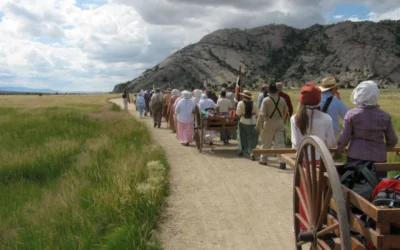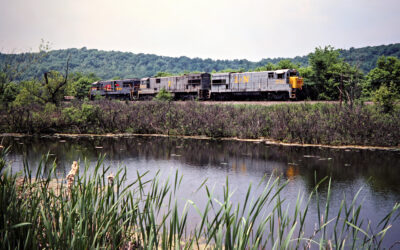Most family researchers find a journey to an archive a potentially serendipitous treat. Uncovering new evidence is possible when we know how to look for it. During the Discovering Your Bluegrass Roots seminar, we hosted multiple Kentucky research experts.
One such expert was Melissa Barker, one of our esteemed board members. As a professional archivist, Barker had many tips for ensuring your time was well spent. However, she had one simple tip for visiting an archive.
In this post, she explains why the vertical files are so useful to genealogists and why you must see them before leaving.
Note: Members can watch the entire session by logging into the Member Portal in the Learning menu.
Video Transcript
[00:00:00] Number one, we’re going to ask about vertical files or subject files.
[00:00:04] Vertical files. I like to say they’re like a box of chocolates. You never know what you’re going to get. Vertical files are a hodgepodge of originals and copies of primary documents and also secondary documents. You can literally find anything in these particular collections.
[00:00:27] You could find that long, lost birth record. You could find a newspaper clipping that you hadn’t been able to find because the newspaper was not saved and microfilmed. Yet, someone clipped it out, and it was saved.
[00:00:42] These kinds of records are usually found behind closed doors. When you go to an archive, a library, (or) historical society building, you know, you sit in that little room where you do your research; there may be some reference books (or) some county histories on the shelf.
[00:00:57] Many times the actual records are not sitting in those rooms. They’re sitting behind closed doors. So, you’re going to see several of these (signs) are going to say, “Ask About.” Because it’s important that you talk to the archivist, to the museum curator, to the librarian, or to the historical society member about these records. If you don’t ask, my philosophy is, if you don’t ask, you don’t get. And so, we need to start talking to these people.
Finding the Vertical Files
[00:01:25] This is a photograph of the vertical files at the Houston County, Tennessee Archives. All right now, we have three filing cabinets full, but it’s growing on a daily basis. We are constantly adding to it.
[00:01:37] How do we add to it? People will walk into the archives, and they will have a newspaper clipping and maybe a program from a high school football game from 1965. And they’ll say, do you want this? If not, I’m going to throw it away. Of course, I want it. So, it isn’t a large enough collection to build a manuscript collection out of. So, it goes into the vertical files.
[00:02:01] Here’s another example. This is the Sparkman Barrel Association membership application from 1933 for Eric Stanfield and Mary Stanfield. She actually donated these to the archives, and like I said, they’re not large enough for a large collection. So, they went into our vertical files.
[00:02:18] What’s important about these for us here locally is that our local funeral home was owned by the Wiseman family up until the 1970s. When Mr. Wiseman passed away, his wife told his daughter, when I die, I want you to destroy all the funeral home records, because it’s nobody’s business about these records. Unfortunately, when Mrs. Wiseman died, her daughter did just that. She destroyed all the funeral home records.
[00:02:46] And so when we run across funeral home records of any kind here in Houston County, we are happy because we know that so much has been destroyed.
Tidbits from Daily Life
[00:02:54] You might find ephemera. Now, ephemera, if you’ll look up, the definition of ephemera is “those types of records that originally should have been destroyed.” They were produced for a short time and then they should have been destroyed, but luckily much of it gets saved. This right here is a handbill for a land auction on Timber Rock.
[00:03:15] This is in our vertical files. And so, this right here would have been something that would have been tacked up on a tree, put in a storefront. Then, after the auction, it would have been torn down and thrown away. And so having things like that that have survived are precious. This particular one is in our vertical files.
[00:03:34] And this one you can’t tell by this (picture) ’cause I’ve really blown it up, but this particular newspaper clipping is only an inch x inch. That’s how small it is.
[00:03:41] We found that in a box. And so, we put it in our vertical files, but it announces the golden anniversary for Mr. and Mrs. John Bagot. If you’re researching Mr. and Mrs. John Bagot, and the newspaper that this particular clipping came out of (if) the whole newspaper wasn’t saved, it wasn’t microfilmed, but yet this (clipping) is sitting in a vertical file. What a treasure trove to be able to find.
Genealogists Should Donate Their Family Group Sheets
[00:04:07] You also may find family group sheets or family histories in vertical files. This is the one for Edmund Herschel Cook. It was donated to the archives.
[00:04:17] As genealogists, I encourage genealogists to donate your family group sheet, to donate a brief history to the local archive where your ancestors lived, because when other researchers come along and they find this information, they may contact you and you can make a connection.
[00:04:37] You may even find photographs and vertical files. Depending on the archives, all of them are different. Some archivists like to put their photographs in vertical files, some archivists like to take and put all their photographs in a one photograph collection to keep them together. You don’t know which way it will be. So, it’s always great to ask.
Other Interesting Items
[00:04:57] This is a photo of Wilson Averitt and Pearl Adams in Houston County, Tennessee. This was one of my favorite things. This is from Skeleton’s Supermarket from the 1950s. It’s actually a sales paper, just like we get today, a sale paper for what they had for sale. Some of the pricing is absolutely phenomenal when you look at it. Compared to what we have today, I would like to have the half-a-gallon of ice milk for 39 cents. This also is in our vertical files because vertical files are usually set up either by surname or the files are going to have subject names, such as the Skeleton Supermarket.
[00:05:38] When you’re looking for vertical files, you may find on the archives website or when you go to the archives, ask them for an index of their vertical files, and then you can run down the index, look for your surnames or look for any important businesses, schools or any kind of subject matters that might be of interest to you. Then you can ask for those files to be pulled or copied.



